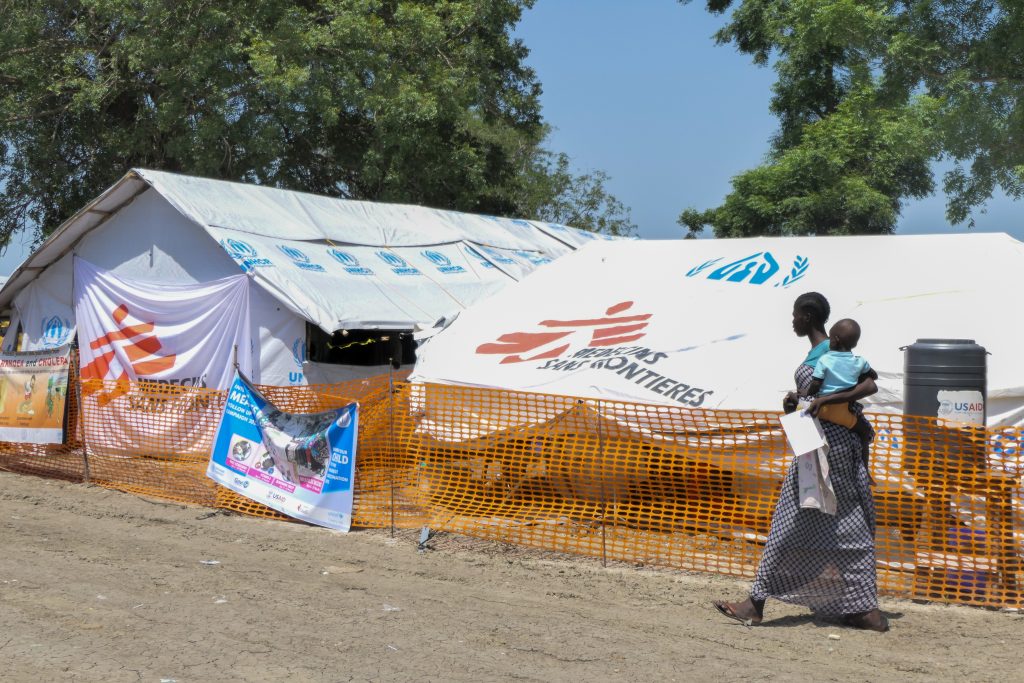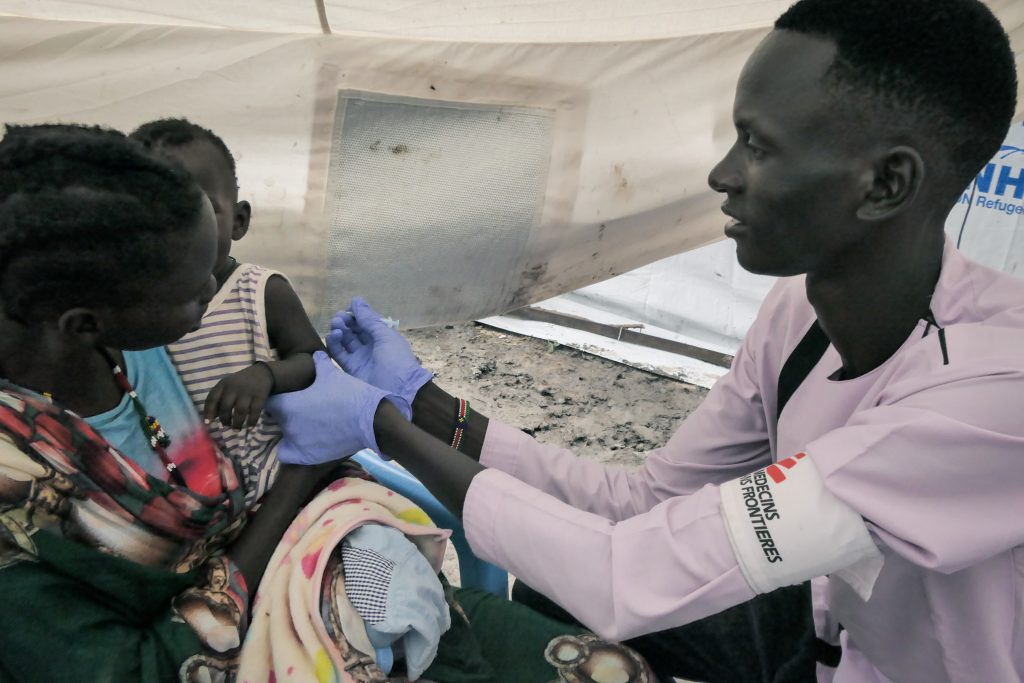During this World Immunisation Week, MSF shares recommendations for how Gavi – which is developing its new five-year strategy amidst looming funding cuts – can strengthen collaboration between governments and humanitarian organisations to ensure that more children up until the age of at least five, especially those living in fragile and humanitarian settings, get their routine vaccination
By Victorine de Milliano, vaccine policy and advocacy advisor, MSF, and Pamela Onango, medical coordinator in South Sudan, MSF
South Sudan– On 10 January 2024, South Sudan declared a measles outbreak in its Western Equatoria state. With an alarming number of people in Western Equatoria never having been vaccinated against measles, there was an urgent need to start a large-scale measles vaccination to curb the spread of the disease in the area and its surroundings, protect people from contracting measles and, ultimately, save as many lives as possible.
However, obstacles around getting and using the measles vaccine in-country meant that it took almost four months for any measles vaccinations to begin in Western Equatoria. In the interim, thousands of people fell ill and at least thirteen people died, seven of whom were children under five years old.
For over five decades, MSF has been vaccinating people through routine vaccination, preventive vaccination campaigns, and in response to disease outbreaks in some of the world’s most challenging humanitarian settings. Sometimes, we – and other humanitarian, non-governmental organisations – are the only providers of vaccination for people who are not reached by government-led vaccination activities. This can happen for various reasons, including security constraints, geographic and infrastructural challenges, and sometimes, deliberate exclusion
Our years of experience have taught us invaluable lessons about vaccinating in humanitarian settings, and it’s because of this that we know the delay in South Sudan was not exceptional. Often, getting access to vaccine supplies requires months of negotiations around how and when they can be accessed – negotiations which often start anew each time there is a need. Such slow-moving coordination wastes valuable time and risks lives.
But we don’t think it has to be this way.
Right now, Gavi, The Vaccine Alliance – an organisation which helps governments of the world’s poorest countries vaccinate children against some of the world’s deadliest diseases – is preparing its strategy for the next five years, and as part of this, designing a “Fragility and Humanitarian Approach” to reach communities consistently missing out on immunisation.
In fragile and humanitarian settings, such as war zones, refugee camps, and hard-to-reach areas cut off from health care, it is often more difficult for people to access routine vaccination services, and ‘zero-dose’* children are disproportionately found in these environments. For example, as of July 2024, 31 World Health Organization member countries with fragile, conflict-affected settings accounted for 55% of unvaccinated children.
Gavi’s effort to address this is therefore much welcomed. However, it must include the recommendations of non-governmental, humanitarian organisations – like us – that have spent years working in and understand these settings.
Returning to South Sudan’s Western Equatoria, a flexible system allowing for rapid access to vaccines could enable faster and smoother emergency vaccination responses. One way to make this happen, would be for Gavi to work with governments and humanitarian organisations together, to ensure a closer collaboration: we don’t operate in a void, and effective cooperation with country governments allows us to better support them and work where they are not.
Specifically, instead of having to negotiate with governments on a case-by-case basis, Gavi should help develop standing agreements to allow humanitarian organisations rapid access to existing in-country vaccine stockpiles in order to complement national immunisation efforts by vaccinating the children that fall outside of national immunisation programmes.
We’ve seen how this can work. In South Sudan’s Upper Nile State, MSF set up mobile clinics to screen and vaccinate displaced people, preventing outbreaks. This relatively simple intervention allowed people outside of national immunisation programmes to receive healthcare, and was successful because of sufficient vaccine supplies and space to work.

There is another critical part to getting vaccines to as many children as possible in hard-to-reach places, which is making sure that when we do vaccinate, including in targeted campaigns, we reach all children who missed out on their basic childhood vaccines, regardless of their age. Unfortunately, due to national policies, age-limited Gavi support and – therefore – limited vaccine supplies, children over the age of two often miss out on vaccination. This leaves older children who are still at an increased risk of falling ill from vaccine preventable diseases unprotected and makes any future response to an outbreak even tougher.
In our experience, missing out on vaccinations can have devastating impacts. In last year’s response to the measles outbreak in Western Equatoria, 20 per cent of children treated for measles at MSF-supported facilities were over five. While the Big Catch Up – an initiative by Gavi, UNICEF and WHO – aims to reach zero-dose children up to the age of five with vaccination, this effort will come to a close at the end of this year. Going forward, we urgently need country policies that allow for vaccination until at least the age of five matched with dedicated financial support from an ambitiously funded Gavi.
Of course, sustainable funding for immunisation is essential. And due to logistical and geographic challenges that often exist in fragile and humanitarian settings, the delivery of vaccines can be more expensive than in “stable” settings. That’s why it’s especially critical for all institutional and government donors to ensure the effort to reach children in humanitarian settings with immunisation is ambitiously supported, both financially and politically.
It’s abundantly clear that we in global health must work better together to reach every child in a fragile or humanitarian setting with lifesaving childhood, routine, or emergency vaccination. Health systems need to be strengthened so that country-led responses remain at the core of immunisation efforts, with humanitarian partners able to support where children are not reached.
This means the learnings and recommendations of humanitarian organisations must be reflected in the policies and practices that aim to reach children in humanitarian settings with vaccination. Actively dismantling the barriers in getting timely access to and using vaccine supplies is a particularly key part of ensuring that children up until at least age five will have a better chance of being protected from vaccine preventable diseases, and getting a real shot at life.

*’Zero-dose’ children are defined as children who haven’t received a single dose of diphtheria, tetanus and pertussis-containing vaccine (DTP3).
Read MSF’s full recommendations on how Gavi can do more to reach people outside of government vaccination activities here, and for more information on Vaccination Barriers in Complex Settings see here.
First published by Health Policy Watch on 25.04.202












